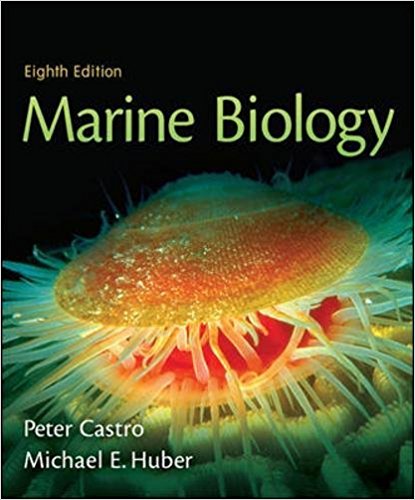Description
Marine Biology 8th Edition By Castro – Test Bank
Chapter 5
Student: ___________________________________________________________________________
- One of the following statements about marine viruses is not true:
A. Are involved in the release of DOM (dissolved organic matter) into the water B. Bridge the gap between the non-living and the living
C. Their genetic material is in the form of DNA or RNA
D. Cause diseases in many types of organisms
E. Consist of minute cells sometimes attached into chains - Bacteriophages are: A. Archea
B. Bacteria C. Protozoa D. Algae E. Viruses
- Prokaryotes differ from eukaryotes in regards to A. Shape of DNA molecules
B. Size of ribosomes
C. Presence of nucleusD. All of the above E. A and B only
- Which of the following is not true of decay bacteria? A. Break down waste products and dead organic matter B. Carry out photosynthesis
C. Are heterotrophs
D. Are particularly abundant in bottom sediments
E. Ensure the recycling of essential nutrients - Bacteria that make their own organic compounds by obtaining energy from chemical compounds and not directly from light are known as:
A. Heterotrophic
B. DecayC. Photosynthetic D. Protists
E. Chemosynthetic - Cyanobacteria are characterized by being: A. Decomposers
B. Found only in the plankton C. Having a glass-like skeleton D. Protists
E. Photosynthetic - Which of the following are classified as autotrophs? A. Cyanobacteria
B. Lysogenic viruses
C. BacteriophagesD. All of the above E. B and C only
- Endophytes are primary producers that live: A. On the surface of planktonic organisms B. Inside primary producers
C. Inside animalsD. On the surface of animals E. Within decay organisms
- Archaea are characterized by being: A. Prokaryotic
B. Autotrophs only
C. Heterotrophs only
D. Found only in extreme environments E. Eukaryotic - Archaea are now being detected in many environments by identifying one of the following chemicals characteristic of the group:
A. Pigments
B. ChlorophyllC. Nucleic acids D. Proteins
E. Carbohydrates - Organisms having a shell made of silica (SiO ): 2
A. Foraminiferans B. Stromatolites C. Cyanobacteria D. Diatoms
E. Ciliates

Reviews
There are no reviews yet.